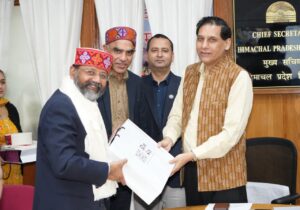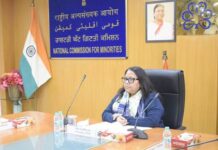 To bolster disaster preparedness and ensure an efficient, tech-enabled, and environmentally responsible response mechanism, a high-level meeting was chaired by Chief Secretary Prabodh Saxena in Shimla today. The meeting saw participation from senior officials of the National Disaster Management Authority (NDMA), National Disaster Response Force (NDRF), State Disaster Response Force (SDRF), Indian Meteorological Department, and stakeholder departments such as NHAI, Geological Survey of India, PWD, and Forest Department.
To bolster disaster preparedness and ensure an efficient, tech-enabled, and environmentally responsible response mechanism, a high-level meeting was chaired by Chief Secretary Prabodh Saxena in Shimla today. The meeting saw participation from senior officials of the National Disaster Management Authority (NDMA), National Disaster Response Force (NDRF), State Disaster Response Force (SDRF), Indian Meteorological Department, and stakeholder departments such as NHAI, Geological Survey of India, PWD, and Forest Department.
The Chief Secretary emphasized that with the increasing frequency and intensity of natural disasters in Himachal Pradesh, it is imperative to strengthen the SDRF. He called for improvements in operational capabilities, adoption of cutting-edge technology, and promotion of sustainable clean-up practices to ensure more effective disaster responses.
Addressing the unique challenges posed by disasters in mountainous and high-altitude areas, Saxena stressed the need for a specialized training module for SDRF teams. This training will include hands-on drone operations for aerial surveys, locating survivors in hard-to-reach areas, conducting real-time damage assessments, and delivering essential supplies like food and medicine with precision.
To make disaster response more data-driven and predictive, the Chief Secretary highlighted the need to develop model guidelines for the use of Artificial Intelligence (AI) in decision support systems. AI, he noted, could revolutionize disaster management by offering predictive analysis, automated damage assessments, optimized resource allocation, and more accurate early warning systems. These advancements will aid in timely evacuations, resource prioritization, and minimizing human error during emergencies. Saxena also emphasized that such AI usage must be ethical, transparent, and supportive of human decision-makers.
The Chief Secretary also addressed a major post-disaster challenge—safe disposal of muck, silt, and debris. He announced plans to develop a standardized muck disposal protocol that focuses on identifying proper disposal sites, promoting bio-engineering solutions for soil conservation, and encouraging the reuse and recycling of debris for construction of protective structures.
In terms of institutional infrastructure, Saxena directed officials to expedite the establishment of the NDRF headquarters in Mandi, along with Regional Response Centres at Nalagarh (Solan district) and Rampur (Shimla district) to decentralize disaster response resources.
NDRF Director General Piyush Goyal informed that various training programs are available on the NDRF website, and SDRF teams from Himachal Pradesh may select modules suitable for their needs. Training will then be conducted accordingly to enhance local capacity.
NDMA Member Krishna S. Vats also shared insights on strengthening the SDRF, while Additional Director General of Police Satwant Atwal Trivedi detailed current activities and reiterated the urgent need to build SDRF strength in light of growing disaster threats.
The meeting was attended by Additional Chief Secretary Kamlesh Kumar Pant, Director-cum-Special Secretary (Disaster Management) D.C. Rana, NHAI Regional Office DGM Rakesh Deepak, and other senior officials. Deputy Commissioner of Mandi Apoorva Devgan joined the proceedings virtually.





